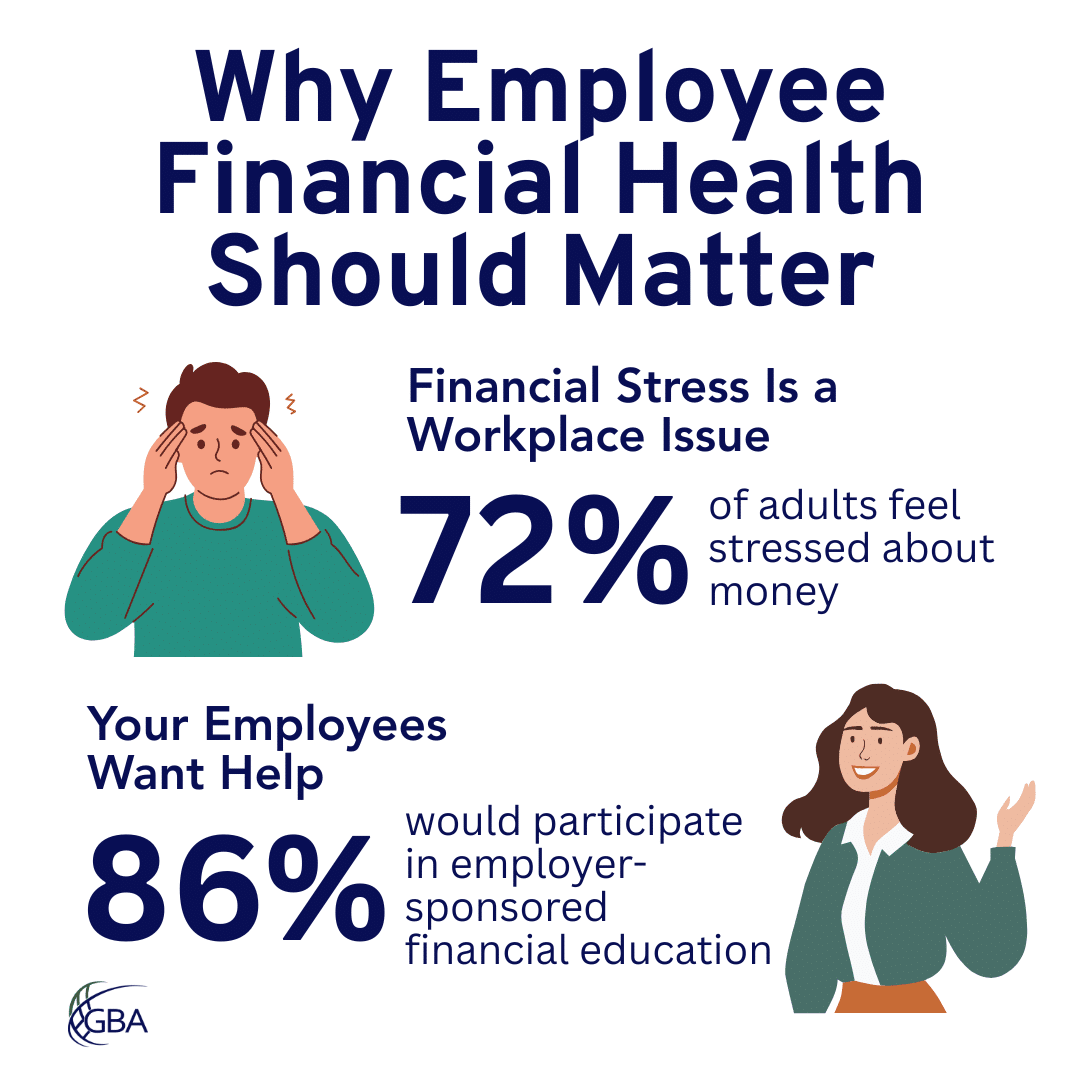Employee Stress & Financial Health
Your employees are stressed, very likely due to concerns about their financial health. According to the 2023 “Stress in America Survey” from the American Psychological Association, money is a top source of stress for Americans: “Among the day-to-day stress categories, health-related stressors (65%), money (63%), and the economy (64%) were reported among the top significant sources of stress in adults’ lives” (https://www.apa.org/news/press/releases/stress/2023/collective-trauma-recovery).
What, me worry?
Experts state that starting at age 25, we should be saving between 11–15% of our pay every year to have what we will need in retirement. Also, according to experts, this is not happening. Forecasts show that there will be a shortfall of over $300,000 per family in retirement in the US by 2050. What is currently a $28 trillion shortfall is projected to be a $137 trillion shortfall across the nation by the World Economic Forum (“We’ll Live to 100 – How Can We Afford It?” May 2017).
A May 2016 Federal Reserve publication, “Report on the Economic Well-Being of U.S. Households in 2015,” found that 46% of adults either could not cover an emergency expense of $400 or would cover it by selling something or borrowing money. The 2016 PricewaterhouseCoopers Employee Financial Wellness Survey found that, of those who carry credit card balances, 29% find it difficult to meet their monthly minimum payments. (The number is even higher for employees with student loans.) Statistics such as these highlight the degree of financial stress carried by many employees. But they also speak to the likelihood that these individuals will take loans from their workplace retirement plan or minimize or eliminate their retirement savings, thereby reducing the likelihood of retiring on time.
Conversely, employees are very receptive and desirous of their employer’s assistance with their financial health.
Your Employees Want Help
Despite the stress, there’s good news: Employees are eager for guidance.
-
86% would participate in employer-sponsored financial education.
-
40% want their employer to take a more active role in supporting financial wellness.
-
Of those offered financial wellness programs, 68% participate (PwC, 2017).
Why Is this an Employer’s Problem?
Some business owners may ask, “Why is the level of my employees’ financial stress a problem?” Several arguments can be made. Here are a couple:
The Business Case
One answer is that having employees who are stressed (or not) affects a business’s bottom line.
For employers, financial stress can translate into lost productivity and increased expenses. The PricewaterhouseCoopers survey found that 46% of employees spend three hours or more each week dealing with issues related to their personal finances, and 44% of employees believe they will have to postpone their retirement, which can burden employers’ health care and disability costs. A study by Willis Towers Watson shows employees who are struggling with their finances are absent nearly double the days of employees who are comfortable with their finances (3.5 days compared with 1.9 days). In addition, as older workers delay retirement, younger workers may feel that their career opportunities are limited, potentially causing them to pursue other avenues and costing the employer valuable human capital.
Providing a well-rounded benefits package, which includes elements to decrease financial stress, such as a retirement plan and some element of financial education, can help not only to attract employees but also to increase their tenure and engagement. Regardless of experience level, employees with higher tenure are more comfortable doing the functions of their job and operating within the corporate culture, which contributes to efficiency.
Bottom Line: Employees who are financially healthy are more likely to be productive and engaged and stay longer.
The Community Case
The traditional model is for an employee to work with one employer during their working years and have a pension with that employer for when they retire; however, nowadays, most employers will acknowledge they no longer expect to have an employee work with them for 30 or more years.
Thinking broadly, then, we could consider the time that an employee spends with an employer as one stint in their life’s journey, or, to compare to a relay, one job could be seen as “one leg of the race.” The result is that an employer has less control over an employee’s overall path to retirement, but employers can make a difference while the employee is working with them. If employers focus their efforts on employee financial health results, they can help their employees as they transition to the next phase of their lives. Providing financial education and tools to help employees then could help to create an overall workforce “community” that experiences lower stress due to finances. This workforce is available to all employers. And if all employers take this same strategic view, then the employee pool of talent, which one day may be employed by you, will be healthier. If you provide for the needs of your employees — and you let them know what you’re providing — there is greater likelihood that they will be loyal.
The Purpose of Employee Benefits
While business owners can sometimes be focused only on benchmarks, it’s important to remember that employee programs are intended to help the employees. If participation in benefits programs is low, we must ask, “Is this program helping? Is this a reflection of the employees or the quality of the program?”
Our observation is that most successful employers take the long view in their compensation strategies and benefit programs. These employers do more than check a box; rather, they measure on an ongoing basis the real impact their compensation programs have on employees. They recognize that helping employees manage their financial health does the following:
- Creates economic benefits for the employer.
- Leads to a healthier overall workforce community (which is greater than the employee population at a particular company).
- Helps employees, and in doing so, fulfills the intentions of the program and is the right thing to do.
For More Information
A well-rounded benefits package can help decrease employees’ financial stress and can also help improve employee retention and engagement. We can help by reviewing your current benefits plan or crafting a new benefits plan to best serve your employees and your business. Our team is here to help! For more information or assistance, please contact our Benefits team at (210) 640–1789, toll-free at 1–888–757–2104, or be******@**********rs.com.
Latest News
Employee Stress & Financial Health
May 21, 2025
Your employees are stressed, very likely due to concerns about their financial health. According to the 2023 “Stress in America Survey” from the American Ps...
READ MORE...Fiduciary Duties & Employer Risks
May 5, 2025
Offering a variety of employee benefits is a key way to find and retain the best employees. However, this perk is not without its risks and challenges for emplo...
READ MORE...Managing PTO Requests
May 5, 2025
Vacation season is coming, and along with it, a deluge of time off requests. Paid Time Off (PTO) is an important benefit for employees and job-seekers. If...
READ MORE...Loading...


